3 Physical Activity, Exercise, and Fitness
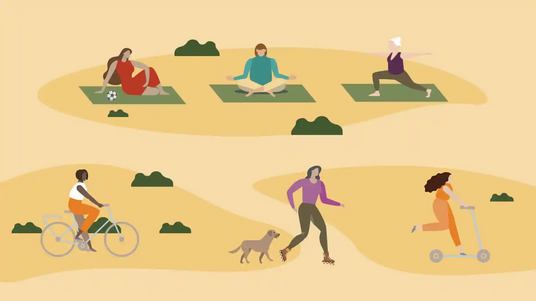
Chapter Objectives
At the end of this chapter, the student should be able to…
- define physical activity.
- understand the benefits of physical activity.
- define exercise.
- be able to explain the difference between physical activity and exercise.
- understand how much physical activity/ exercise is recommended.
- define fitness.
- identify and define the 5 health-related components of fitness.
- identify and define the 6 skill-related components of fitness.
The Basics of Physical Activity, Exercise, And Fitness
Physical Activity And Exercise
Consider how you use these terms. Take a moment and think about how you would define the term “physical activity?” How would you define the term “exercise?” How are the two the same, and how are they different?
The terms physical activity and exercise are often used interchangeably, but there are some important differences. The American College of Sports Medicine (ACSM, 2013) defines “physical activity” as “any bodily movement produced by the contraction of skeletal muscles that results in a substantial increase in caloric requirements of resting energy expenditure (ACSM, 2013).” On the other hand, they define “exercise” as “a type of physical activity consisting of planned, structured, and repetitive bodily movement done to improve or maintain one or more of the components of physical fitness (ACSM, 2013).”
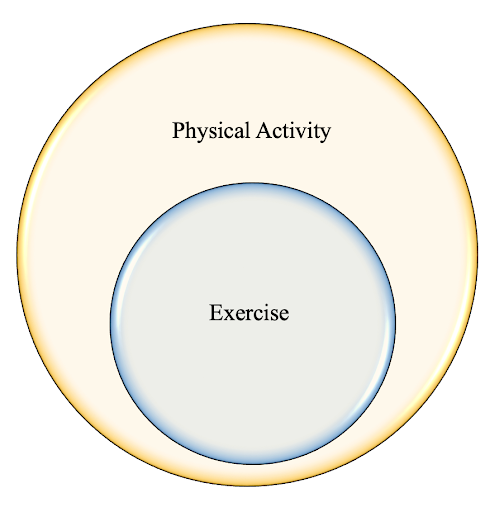
Based on these definitions, any form of exercise is physical activity but not all physical activity is exercise. What makes something exercise instead of physical activity is largely based on the intent. For example, if you go for a hike because you are an avid nature lover, that activity is more along the lines of physical activity, but if you go on a hike because you are trying to improve or maintain your cardiovascular endurance (more to come on that), or get a specific number of steps in, or expend a certain amount of energy, then that activity is also exercise! There are activities we might do for enjoyment or work that cause muscle contractions and a substantial increase in energy expenditure that are not exercise. For example, splitting wood, construction, or shoveling snow are all examples of physical labor that would fall under physical activity and would not be considered exercise.
Fitness
According to the ACSM (2013), physical fitness is “a set of attributes or characteristics that individuals have or have achieved that relates to their ability to perform physical activity.” Above, you learned that exercise differs from physical activity because, with exercise, you are specifically aiming to improve or maintain an area of physical fitness. These “areas” or components can be grouped into health-related components of fitness and skill-related components of fitness.
Components Of Fitness
We will discuss the five health-related components of fitness and the six skill-related components of fitness. The health related components are the components of fitness that are important in order to maintain health. The health-related components of fitness include cardiovascular fitness, muscular strength, muscular endurance, flexibility, and body composition (ACSM, 2013). Your skill-related components of fitness are aspects of fitness that will benefit you from a sport or athletic standpoint but are not considered essential for optimal health. Skill-related components of fitness include agility, coordination, balance, power, speed, and reaction time (ACSM, 2013). In the following section, each component of fitness is defined and explained. Throughout subsequent chapters, each of the health-related components will be discussed in greater detail and assessed.
Health-Related Components of Fitness
The health-related components are the components of fitness that are important aspects of health. The health-related components of fitness include cardiovascular fitness, muscular strength, muscular endurance, flexibility and body composition (ACSM, 2013). It is important to note that while you need these components of fitness for general health, that does not mean we all must achieve high levels of fitness in these areas to maintain health. For example when we talk about cardiovascular fitness, you can have a sufficient cardiovascular fitness level in order to maintain health, but you don’t have to be a marathon runner. Similarly, flexibility is important for overall health and wellness, but you don’t need to have dancer- or gymnast-level flexibility to have enough for health. With that said, having a high or superior level of fitness in any of these areas is great, if that’s what you want to do!
- Cardiovascular Fitness– The ability of the body to transport oxygen.
- Muscular Strength– The ability of skeletal muscles to overcome resistance.
- Muscular Endurance– The ability of skeletal muscle to resist fatigue.
- Body Composition– The ratio of fat vs fat free mass.
- Flexibility– The available range of motion at a joint.
(ACSM, 2013; Porcari et al., 2015)
Brainstorm some activities you could participate in that would help you improve your level of fitness in each area.
Moving on in this text, each of the above levels of fitness will be addressed in detail. You will have the opportunity to assess your current level of fitness in each area, allowing you to determine both your strengths and areas of improvement, and learn what you can do to either maintain or improve your current levels of fitness.
Skill Related Components of Fitness
Skill related components of fitness are those that are not necessary for optimal health, but are often important in sport and athletic endeavors. For example your overall speed does not impact health, but it is important in many sports.
- Speed – The ability to move quickly from one point to another.
- Agility - The ability to move quickly with changes in direction and/ or other movements.
- Power – The ability to overcome a force at speed.
- Coordination – The ability to move with control and accuracy.
- Balance – The ability to maintain equilibrium when stationary or moving.
- Reaction Time – The time it takes to respond to a stimulus.
(ACSM, 2013; Porcari et al., 2015)
Physical Activity / Exercise Recommendations
When we talk about how much exercise someone should get, we need to consider the goal of the individual. For example, if someone wants to be a high level athlete, they are going to need to commit more time to exercise than someone who is not. The time commitment could also look different if weight loss is a goal vs. exercise for health. For now, we will just talk about general recommendations for a healthy lifestyle. According to the ACSM (2013), adults between the ages of 18-65 who are healthy, should at least participate in 150 min (example: 30 min/ 5 times a week) of moderate intensity aerobic (think exercise that raises your heart rate and breathing rate) a week or participate in 60 min (20 min/ 3 times a week) of vigorous exercise. In subsequent chapters we will address determining intensity!
Before we move on to other minimum recommendations, it is also important to note that if it is not possible to complete your aerobic exercises all in one 30 min or 20 min session that is ok. You can break the exercise time down into multiple 10 minute sessions (or shorter if necessary). The end goal should be to complete them in one session, but remember, in the absence of contraindications, something is always better than nothing!
NOTE: Sometimes there is too much of a risk for someone to exercise. The term contraindication is used if the risk is greater than the benefit. This is why health screening is important! You will be completing a PARQ (physical activity readiness questionnaire below).
The ACSM (2013) recommends all adults participate in activities that increase muscular strength and/or endurance two to three times a week. Activities that would fall in this category would be weight training exercises like lifting weight, using resistance bands, or body weight resistance exercises. It is important to note that 48 hours rest should be given between resistance training in the same muscle group (ACSM, 2013). We will go into more detail on muscular strength and endurance in chapter 6. Finally, the ACSM also recommends participating in flexibility type activities two to three times a week. Examples include stretching and yoga. More information on flexibility can be found in chapter 7.
Again, it is important to remember that the above recommendations are just the minimum guidelines. Many people have goals that may require them to do more than minimum, but for your general health/ wellness you should aim to at least complete the above. It is also important to note that it is ok to build up to these recommendations, and that doing something is always better than doing nothing! So start where you are, and where you are comfortable.
While most people are healthy enough to meet these minimum recommendations, it is never a bad idea to check with your doctor. Below is a PAR-Q (Physical Activity readiness questionnaire). It is important that you complete this form truthfully and completely before you begin any physical activity in this class! Not often, but sometimes, people have contraindications to exercises. Meaning because of an acute or chronic condition they have it may not be safe for them to participate in certain types of physical activity.
Benefits of Physical Activity / Exercise:
There are many benefits to being physically active. The figures below (from the center for disease control and prevention, CDC) outline benefits of being physically active for adults, children, and older adults (65 and older). More specifics about these benefits can be found at the following CDC webpage.
Health Benefits of Physical Activity for Adults
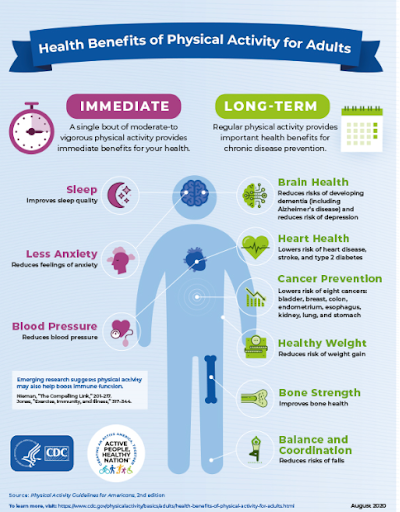
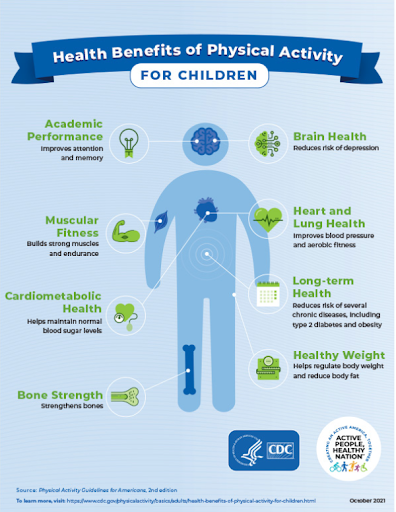
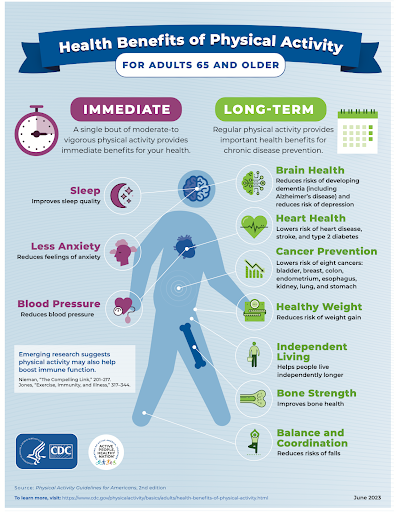
![]() Using the CDC images above and the link provided, take a moment and note the benefits of physical activity that you were aware of and those that you were not aware of before today.
Using the CDC images above and the link provided, take a moment and note the benefits of physical activity that you were aware of and those that you were not aware of before today.
Practical Applications/ Laboratory Activities
Complete the following Physical Activity Readiness Questionnaire (PAR-Q). Moving forward, some laboratory activities will require you to be physically active. It is important that you first make sure it is safe for you to do so at this time
2023 PAR-Q+: The Physical Activity Readiness Questionaire for Everyone
Self Reflection
Complete: Barriers to Being Active Quiz
Reflect on your results.
- What (if any) potential barriers did you score a 5 or more in? If you did not receive a 5 or more in any area, select the two categories in which you scored the highest.
- Why do you think these categories pose the greatest challenge/ barrier for your becoming physically active?
- What can you do to overcome the barriers (listed in question 1)?
- Which potential barriers do not seem to be barriers for you at all? Why aren’t these barriers?
In Chapter 3, you learned about physical activity, exercise, and fitness. The ACSM (2013) defines physical activity as “ any bodily movement produced by the contraction of skeletal muscles that results in a substantial increase in resting energy expenditure (ACSM, 2013).” They define exercise as a type of physical activity consisting of planned structures and repetitive bodily movement done to improve or maintain one or more of the components of physical fitness (ACSM, 2013).” Fitness is defined as “the ability to carry out daily tasks with vigor and alertness, without undue fatigue, and with ample energy to enjoy leisure-time pursuits and meet unforeseen emergencies (ACSM, 2013).” There are different areas of fitness, which means you can have a high level of fitness in one area and not as high of a level in another area. There are five health-related components of fitness, including cardiovascular fitness, muscular strength, muscular endurance, flexibility, and body composition (ACSM, 2013). Additionally, there are six skill-related components of fitness. Skill-related components of fitness include agility, coordination, balance, power, speed, and reaction time. In Chapter 3, you also learned about minimum recommendations for physical activity/ exercise. More specifics related to exercise can be found in Chapters 5, 6, and 7.
Key Terms / Phrases:
Media Attributions
- Physical activity possibly © By Hunterkennedyuvic - Own work, CC0, https://commons.wikimedia.org/w/index.php?curid=146702337 is licensed under a Public Domain license
- Physical activity © Jessica Alsup is licensed under a CC BY-SA (Attribution ShareAlike) license
- Benefits of physical activity © CDC is licensed under a Public Domain license
- Benefits of physical activity for children © CDC is licensed under a Public Domain license
- Benefits of physical activity 65 over © CDC is licensed under a Public Domain license
- Light bulb
Physical activity is “any bodily movement produced by the contraction of skeletal muscles that results in a substantial increase in caloric requirements of resting energy expenditure (ACSM, 2013).”
Exercise is “a type of physical activity consisting of planned, structured, and repetitive bodily movement done to improve or maintain one or more of the components of physical fitness (ACSM, 2013).”
Fitness is “a set of attributes or characteristics that individuals have or have achieved that relates to their ability to perform physical activity (ACSM, 2013).”
The health-related components of fitness include cardiovascular fitness, muscular strength, muscular endurance, flexibility, and body composition (ACSM, 2013).
Skill-related components of fitness include agility, coordination, balance, power, speed, and reaction time (ACSM, 2013).
The ability of the body to transport oxygen (ACSM, 2013; Porcari et al., 2015).
The ability of skeletal muscles to overcome resistance (ACSM, 2013; Porcari et al., 2015).
The ability of skeletal muscle to resist fatigue (ACSM, 2013; Porcari et al., 2015).
Flexibility is the available range of motion at a joint (ACSM, 2013; Porcari et al., 2015).
The ratio of fat vs fat free mass (ACSM, 2013; Porcari et al., 2015).
Skill-related components of fitness include agility, coordination, balance, power, speed, and reaction time (ACSM, 2013).
The ability to move quickly from one point to another (ACSM, 2013; Porcari et al., 2015).
The ability to move quickly with changes in direction and/ or other movements (ACSM, 2013; Porcari et al., 2015).
The ability to overcome a force at speed (ACSM, 2013; Porcari et al., 2015).
The ability to move with control and accuracy (ACSM, 2013; Porcari et al., 2015).
The ability to maintain equilibrium when stationary or moving (ACSM, 2013; Porcari et al., 2015).
The time it takes to respond to a stimulus (ACSM, 2013; Porcari et al., 2015).

